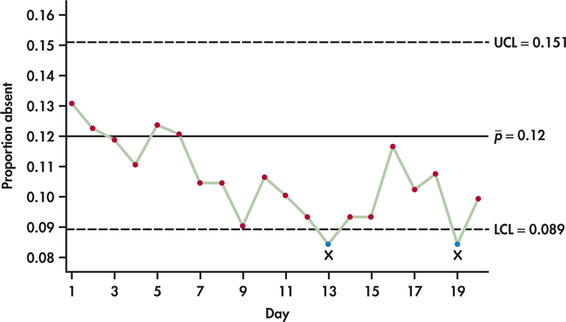EXAMPLE 12.11 Absenteeism Rate p Chart
absent
CASE 12.3 Are your actions effective? You hope to see a reduction in absenteeism. To view progress (or lack of progress), you will keep a p chart of the proportion of absentees. The plant has 987 production workers. For simplicity, you just record the number who are absent from work each day. Only unscheduled absences count, not planned time off such as vacations.
Each day you will plot
ˆp=number of workers absent987
You first look back at data for the past three months. There were 64 workdays in these months. The total workdays available for the workers was
(64)(987)=63,168 person-days
Absences among all workers totaled 7580 person-days. The average daily proportion absent was therefore
ˉp=total days absenttotal days available for work=758063,168=0.120
The daily rate has been in control at this level.
These past data allow you to set up a p chart to monitor future proportions absent:
UCL=ˉp+3√ˉp(1−ˉp)n=0.120+3√(0.120)(0.880)987=0.120+0.031=0.151CL=ˉp=0.120LCL=ˉp−3√ˉp(1−ˉp)n=0.120−3√(0.120)(0.880)987=0.120−0.031=0.089
Table 12.8 gives the data for the next four weeks. Figure 12.18 is the p chart.
| Day | M | T | W | Th | F | M | T | W | Th | F |
| Workers absent | 129 | 121 | 117 | 109 | 122 | 119 | 103 | 103 | 89 | 105 |
| Proportion ˆp | 0.131 | 0.123 | 0.119 | 0.110 | 0.124 | 0.121 | 0.104 | 0.104 | 0.090 | 0.106 |
| Workers absent | 99 | 92 | 83 | 92 | 92 | 115 | 101 | 106 | 83 | 98 |
| Proportion ˆp | 0.100 | 0.093 | 0.084 | 0.093 | 0.093 | 0.117 | 0.102 | 0.107 | 0.084 | 0.099 |
